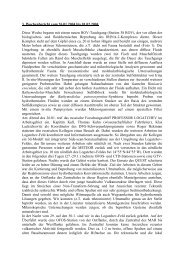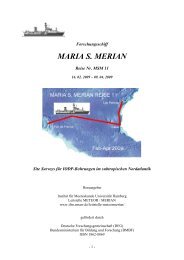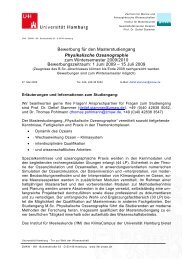MSM01_Expeditionsheft.pdf - Institute of Oceanography, University ...
MSM01_Expeditionsheft.pdf - Institute of Oceanography, University ...
MSM01_Expeditionsheft.pdf - Institute of Oceanography, University ...
Sie wollen auch ein ePaper? Erhöhen Sie die Reichweite Ihrer Titel.
YUMPU macht aus Druck-PDFs automatisch weboptimierte ePaper, die Google liebt.
domorphosen nachaus Pyritknollen bilden.<br />
Die Sauerst<strong>of</strong>fisotopen variieren zwischen<br />
0.7‰ und 5.5‰. Die Kohlenst<strong>of</strong>fisotopen<br />
sind mit -46‰ bis -20‰ PDB stark an 13 C<br />
abgereichert. Diese Daten werden als eine<br />
Mischung aus tiefem, thermogenen und flachem,<br />
biogenen Methan interpretiert. Die<br />
ausgedehnten Schlotfelder eröffnen neue<br />
Überlegungen zur Bedeutung der Kohlenwasserst<strong>of</strong>f-Austritte<br />
im Golf von Cadiz und<br />
darüber hinaus zur aktiven Rolle des Olistostrom-Akkretionskomplex<br />
des Gibraltar-Bogens.<br />
Die im Golf von Cadiz gesammelte<br />
Makr<strong>of</strong>auna umfasst mehrere Pogonophoren<br />
Arten der Genera Siboglinum, Polybrachia<br />
und Oligobrachia. Die Unterschiede in der<br />
räumlichen Verteilung der Arten werden<br />
hauptsächlich auf unterschiedliche<br />
Wassertiefenpräferenzen zurückgeführt.<br />
Eine höhere Artendiversität tritt inbesonders<br />
an den tieferen Schlammvulkanen in der<br />
portugiesischen EEZ auf. Muscheln des<br />
Genus Thyasira (ein lebender Organsimus<br />
und Schill), deren komplexe Gänge<br />
Sedimente bis in 8 cm Tiefe mit Sauerst<strong>of</strong>f<br />
versorgen können, wurden ebenfalls in der<br />
portugiesischen EEZ gefunden.<br />
Videoschlitten-Transekte aus dem<br />
marokkanischen Sektor wiesen das<br />
Vorkommen von von Klappmuscheln<br />
(wahrscheinlich Solemya mediterranea;<br />
nach. Die hier gefundenen Pogonophoren<br />
und Bivalvia sind bekannt für ihre Symbiose<br />
mit Bakterien, mit denen sie sogenannte<br />
chemoautotrophe Lebensgemeinschaften<br />
bilden, die durch den Fluidfluss an<br />
Schlammvulkanen mit Energie versorgt<br />
werden. Chemoautotrophe<br />
Lebensgemeinschaften beeinflussen die<br />
Geochemie der Sedimente nachhaltig;<br />
insbesondere Bivalvia mit einem hohen<br />
Bioturbationsvermögen verändern den<br />
Chemismus der Sedimente. Sie bilden<br />
gleichzeitig durch ihr Vorkommen das<br />
Auftreten von Fluidemissionen ab und<br />
können so als Indikatororganismen für<br />
Fluidflüsse genutzt werden, wobei die<br />
Artenzusammensetzung und Dichte<br />
chemoautotropher Organismen mit der<br />
- 25 -<br />
glomerates <strong>of</strong> pseudo-pyrite framboids. 18 O<br />
isotopic values vary from 0.7 to 5.5‰<br />
whereas 13 C values indicate that chimney<br />
carbonates are moderately depleted in 13 C,<br />
ranging from -46‰ to -20‰ PDB, interpreted<br />
as formed from a mixture <strong>of</strong> deep<br />
thermogenic hydrocarbons and shallow biogenic<br />
methane. These vast fields <strong>of</strong> carbonate<br />
chimneys imply new considerations on<br />
the importance <strong>of</strong> hydrocarbon fluid venting<br />
in the Gulf <strong>of</strong> Cadiz and, moreover, on the<br />
active role <strong>of</strong> the olistostrome/ accretionary<br />
wedge <strong>of</strong> the Gibraltar arc.<br />
The macr<strong>of</strong>auna collected in the Gulf <strong>of</strong><br />
Cadiz included several species <strong>of</strong> pogonophoran<br />
worms belonging to the genera Siboglinum,<br />
Polybrachia and Oligobrachia.<br />
Variations in the species distribution are<br />
mainly depth-related with a higher diversity<br />
occurring at the deeper Portuguese mud<br />
volcanoes. Thyasirid bivalves (one living<br />
specimen and several empty shells), whose<br />
complex burrow systems oxygenate the<br />
sediments to a depth <strong>of</strong> more than 8 cm,<br />
were also recovered in the Portuguese sector.<br />
Video footages from the Moroccan sector<br />
showed evidence <strong>of</strong> dense clam beds<br />
(probably Solemya mediterranea). These<br />
pogonophoran and bivalve species are<br />
known to contain bacterial symbionts and<br />
form chemosynthetic communities that are<br />
sustained by fluid expulsion through mud<br />
volcanoes .Chemoautotrophic organisms<br />
may interact with the sediment properties:<br />
high levels <strong>of</strong> bioturbation are associated<br />
with the dense beds <strong>of</strong> the bivalves that can<br />
cause significant changes in the chemical<br />
characteristics <strong>of</strong> the sediment due to the<br />
activity <strong>of</strong> their symbionts. On the other<br />
hand these organisms respond to the environment<br />
characteristics and may also be<br />
used as indicators <strong>of</strong> fluid emission: variations<br />
in the density <strong>of</strong> Pogonophora (number<br />
<strong>of</strong> tubes per m 2 ) can be related to the intensity<br />
or chemistry and regularity or persistence<br />
<strong>of</strong> fluid emissions in seepage areas. No<br />
Pogonophora were recovered from the<br />
Spanish field, while the highest densities<br />
were found at the Student, Ginsburg (Moroccan<br />
sector) and Bonjardim (Portuguese


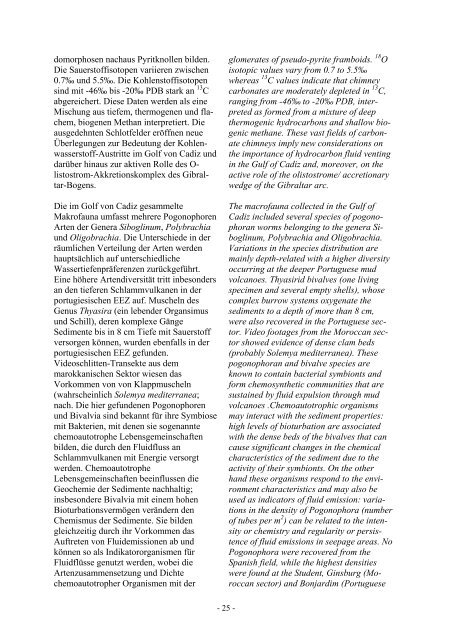
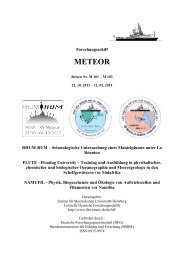

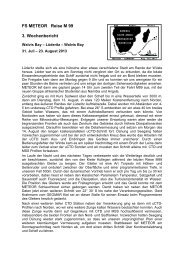
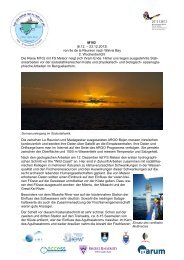
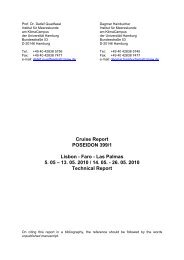
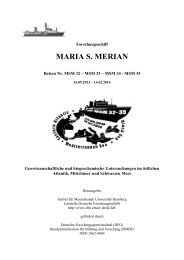
![Expeditionsheft Reisen M99-M100 [pdf] - Institute of Oceanography ...](https://img.yumpu.com/22533092/1/184x260/expeditionsheft-reisen-m99-m100-pdf-institute-of-oceanography-.jpg?quality=85)
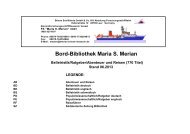
![Darstellungen [pdf]](https://img.yumpu.com/22533086/1/184x260/darstellungen-pdf.jpg?quality=85)



